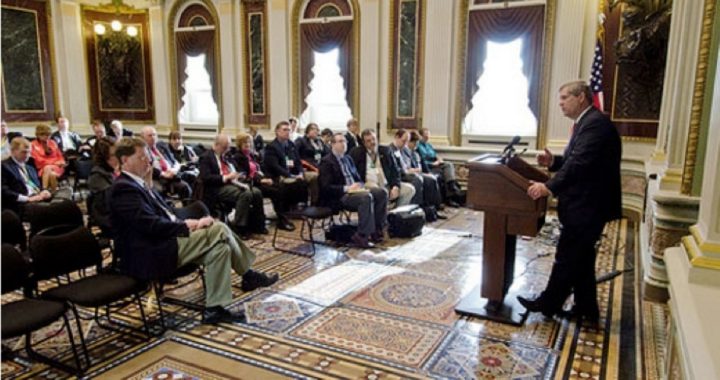
In an interview this week, Agriculture Secretary Tom Vilsack (at lectern) said spending schemes proposed by House Republicans calling for deep cuts, particularly for welfare programs like food stamps, are grounding a heavy obstacle for passage of a farm bill that addresses a slew of programs slated to expire in September.
Vilsack provided some support for the current version of the bill, which was passed out of the Senate Agriculture Committee last week, even though it includes nearly $10 billion less in deficit reduction than President Obama’s last budget proposal. However, Vilsack asserted, such differences are meek compared to differences with the House. “This is still a long way from where it needs to be,” he said in an interview with The Hill. “It isn’t so much what I want to see different as what you need to get the votes you need to get it through the process.”
The bipartisan farm bill, authored by Sens. Debbie Stabenow (D-Mich.) and Pat Roberts (R-Kan.), would purportedly shave $23 billion off the deficit by consolidating programs, terminating unnecessary direct payments, and ramping up enforcement of food assistance fraud. The spending cuts are portioned as $15 billion from farm programs, $6 billion from conservation projects, and the rest relating to nutrition and other programs. Senate aides expounded on the legislation:
- Eliminates not only direct payments, but the average crop revenue election program known as ACRE, the permanent disaster program known as SURE, and target prices as a trigger for payments.
- Creates a new Ag Risk Coverage program known as ARC that allows crop farmers to choose whether to use a county or individual trigger for payments, with lower payments if the farmer chooses the individual trigger, but with a payment limit for either program of $50,000.
- Scales back the size of the Conservation Reserve Program, the Environmental Quality Incentives Program and the Conservation Security Program and groups other conservation programs.
- Says that payments under the Low Income Heating and Energy Program can help qualify people for supplemental nutrition assistance program (SNAP, also known as food stamps) only if the payments are $10 per month or higher.
“Perhaps the larger barrier and the greater challenge will be finding that common ground between the Senate proposal, the president’s proposal — which are pretty much aligned — and the House which has proposed up to $200 billion of cuts in both commodity, conservation and nutrition programs,” the Agriculture Secretary suggested.
The House’s 2013 budget, authored by Rep. Paul Ryan (R-Wis.), proposes that food stamps be block granted to the states, which analysts say would prompt significant spending cuts. Vilsack countered that the GOP cuts would not only blight poor families on food stamps, but farmers could lose up to $20 billion in direct income payments. “That’s obviously just not going to happen,” he said, and “[i]f that’s what it takes to get House votes to get this bill through the process, that’s obviously a problem.”
The Obama administration’s renewed focus on the farming industry seems to fall in line with the President’s uncompromising campaign for a second presidential term, as Mr. Vilsack himself recently acknowledged that the Midwest’s growing farm economy should offer Obama a prominent advantage over his Republican rivals. Yahoo! News reported:
The former Iowa governor said farm income and commodity prices are strong and likely will remain that way for the rest of the year. The Democrat said Obama can take some credit for those trends, arguing that the president has put a heavy focus on boosting exports of farm commodities and made increasing trade a top priority.
That, Vilsack said, could be crucial in the November election since several Midwest states are seen as swing states. Vilsack said one of his jobs this year will be reminding people how well the farm economy is doing and Obama’s role in that success.
“The fact is we have record farm income, record exports and one out of every 12 jobs is connected to agriculture and it’s a good news story,” Vilsack boasted in an interview on Iowa Public Television’s “Iowa Press” program. “Agriculture has been helping to get this country back on track and I think it’s basically providing a road map for recovery.”
The Agriculture Secretary not only touted the purported accomplishments of the administration’s domestic policies, he specifically pointed out “the important role that agriculture plays” in the U.S. economy: “I think it’s underappreciated. Farmers and ranchers are extraordinary in terms of their productivity, and we need to get them a little bit more attention and appreciate them a little bit more.”
During the annual North American Agricultural Journalists convention last month, Vilsack re-branded the farm legislation, renaming it the “Food, Farm, and Jobs” bill, even insisting during a Q&A session that journalists rephrase to use his new label for the legislation. “The Food, Farm and Jobs Bill,” he averred, “will be about the food we eat, the food we trade, the bio-economy, research and development, and about local and regional food systems.”
In terms of his criticisms toward Republicans over food stamp spending cuts, Vilsack’s past advocacy indicates he has a soft spot for such welfare programs. In fact, he is such a strong advocate, he suggested last August that food stamps, oddly enough, are a boon for the U.S. economy:
I should point out, when you talk about the SNAP [Supplemental Nutrition Assistance Program] program or the food stamp program, you have to recognize that it’s also an economic stimulus. Every dollar of SNAP benefits generates $1.84 in the economy in terms of economic activity. If people are able to buy a little more in the grocery store, someone has to stock it, package it, shelve it, process it, ship it. All of those are jobs. It’s the most direct stimulus you can get in the economy during these tough times.



